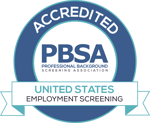
The difference between a background check and E-Verify is based on the purpose of each and surrounding regulations.
A consequence of not understanding these differences often results in misuse of the respective service. The actual cost can easily reach thousands if not millions in fines, civil suits and penalties (E-Verify and Background Screening), just to name a few.
Here, you’ll find key differences between background checks and E-Verify followed by further elaboration. Enjoy!
Key Differences: Background Checks and E-Verify
Background checks can be run as part of a hiring or onboarding process, as permitted by law, as well as throughout the term of employment. E-Verify is only run once after an offer of employment has been made and accepted, but no later than the third business day after the employee starts work for pay. In short, E-Verify is a supplement to Form I-9; treat it similarly.
The goal of a background check is to gain insight on your applicant/employee in order to make an employment decision. The goal of E-Verify is to electronically verify employment eligibility with the Social Security Administration (SSA) and Department of Homeland Security (DHS) based on the information from a completed Form I-9.
The results of a background check can influence an employer’s hiring or employment decision. The results of E-Verify can not influence employment, unless if the result is a Final Non-Confirmation.
Background Checks
What is a background check
A background check (background screen, background report, or consumer report) is a collection of information that is requested through Choice Screening for the purposes of employment or tenancy decisions. Reports typically include:
SSN Verification & Address History
Employment & Education Verification
When is a background check run
Background checks are most often part of the hiring and/or interview process, increasingly pushed later into the interview/hire/employment stages as a result of Fair Chance Acts (Ban-the-Box). These acts often prohibit employers from inquiring about criminal records during interviews or even after an offer of employment has been made or accepted. Here’s a useful site for Ban-the-Box updates - http://www.nelp.org/.
Despite such legislation, background screening will continue to see widespread use for pre-employment decision making and increasingly for ongoing employment, promotions, transfers and annual screening.
How often can a background check be run
Employers can run a background check multiple times on the same individual. Although it is most often part of the pre-employment/hiring process, many consent forms, such as our online consent form, also cover background screening throughout the term of employment.
Government agencies and laws – background checks
The background screening industry is governed by the Federal Trade Commission (FTC) and the Consumer Financial Protection Bureau (CFPB). This is true even when a background report does not include a credit report. Although the EEOC is not a governing agency, its aggressive focus on the background screening industry must be noted.
At the federal level, the Fair Credit Reporting Act (FCRA) established the law consumer reporting agencies (such as Choice Screening) and employers must follow. There are dozens of local and state laws that address background screening, including over 100 Ban-the-Box legislation.
Highly publicized class action lawsuits draw most attention to background screening, such as a March 2016, $12 million settlement by Wells Fargo. We’ve written about various other settlements here.
Background Check compliance
Employers should remain familiar with the below list at a minimum and seek all legal advice from qualified counsel. Doing so will considerably mitigate legal risk, helping you maintain compliant practices.
Use this to get started in the right direction:
- Consent Forms – Employers must have a signed consent form before initiating a background report. It must be a stand alone, clear and conspicuous document consisting only of the authorization and disclosure.
- ID’s – Employers can ask to see specific forms of identification without restriction. For example, if you want to confirm current address or legal name, you can ask to see a driver’s license. (This is in contrast to Section 2 Form I-9 instructions.)
- Permissible Purpose – Some services come with restriction. For example, employers must have permissible purpose (ability to show a direct relationship between the service being run and the position for employment) before running a credit report, such as salary exceeding $75,000 per the FCRA. In nearly all circumstances, an employer is not permitted to use a credit score to influence an employment decision. Additional standards and restrictions are outlined in the FCRA and various local laws.
- Adverse Action – Any time a decision is made that was influenced by a background report and negatively impacts the subject of the report, an employer must send adverse action letters. To learn more about adverse action, read this article outlining Adverse Action Compliance.
- The Dispute – Closely tied to adverse action, the dispute process gives an applicant the opportunity to identify and rectify inaccuracies on a background report. To emphasize the importance of the dispute process, the FCRA requires that employers provide a copy of a report to their applicant/employee when requested as well as during the adverse action process. Without a copy of the report, inaccuracies would not otherwise be identified.
E-Verify
What is E-Verify
E-Verify is an online application maintained by USCIS and used to submit information from a completed Form I-9 via E-Verify to the Social Security Administration (SSA) and Department of Homeland Security (DHS) for electronic verification of employment eligibility. E-Verify is either voluntarily used as an optional supplement to Form I-9, or required by law. E-Verify case results receive direct authorization from both SSA and DHS, establishing a vast distinction between this and SSN background screening services.
When is E-Verify Run
E-Verify can only be run on new employees after an offer of employment has been made and accepted. Additionally, E-Verify must be initiated before the end of the third business day after the employee has started work for pay – similar to Form I-9 rules.
Importantly, E-Verify can not be used for the purposes of “background screening” or “checking a SSN or identity” on an applicant. Misuse of E-Verify for reasons such as this can carry hefty fines in addition to other penalties.
Read more about recent Form I-9 fine increases as of August 1, 2016
How often can E-Verify be run
An employee can not be E-Verified more than once during the term of employment unless permitted by law. Running an employee more than once can result in fines and penalties.
Government agencies and laws: E-Verify
Agencies governing E-Verify include the United States Citizenship and Immigration Services (USCIS), who operates E-Verify, and the U.S. Immigration and Customs Enforcement (ICE), who performs employer audits of Form I-9 and E-Verify.
In addition to federal laws for employment eligibility verifications (which you are already familiar with from Form I-9) various local and state laws require E-Verify. Specific industries are also required to E-Verify all employees, such as agriculture.
ICE openly admits their intention to increase audits every year and target specific industries and jurisdictions. Although no one is immune, if you have a FAR-Clause, belong to an industry required to use E-Verify or operate in a jurisdiction with E-Verify mandates, be aware you are especially vulnerable to an audit.
Use this Guide for Form I-9 Internal Self Audits
E-Verify compliance
Every time an employee is hired, Form I-9 must be completed for that employee. Unless required by law, E-Verify is an optional electronic verification of employment eligibility with SSA and DHS.
Primary areas of compliance with E-Verify, specifically, include:
- E-Verify is not a replacement for, nor is it the same as, Form I-9. It cannot not be used to “screen” employees or applicants.
- Employers who use E-Verify, must do so in a consistent manner for all employees. Failure to do so can result in penalty and risks discrimination allegations.
- E-Verify employers must conspicuously display two participation notices – E-Verify Participation and Right to Work – in both English and Spanish. Nineteen additional languages are available.
- E-Verify can only be run after an employee has accepted a job offer, but must be run before the end of the third business day after the employee has started work for pay.
- E-Verify can only be run once on a new employee and follows similar rules to Form I-9 for rehires, unless permitted by law. This is true even in the case of expiring work authorization documents.
- A Tentative Non-Confirmation (TNC) may not be used to take adverse action against an employee.
- Only in the case of a Final Non-Confirmation or a DHS No-Show result, may an employer take adverse action against an employee based on the E-Verify results.
- If you are unsure of how to proceed based on E-Verify results, reach out for support.
In Conclusion
Background Screening and E-Verify serve mutually exclusive purposes for employers: one is to search background of applicants and employees, while the other is to electronically verify employment eligibility via SSA and DHS based on the completed Form I-9.
In just one blog, we couldn’t possibly cover every aspect of either… even in a post this long. As a professional background screening company, we can offer guidance and support, but can not give legal advice – we’re not attorneys and do not want to steer you wrong! It is important to work closely with your legal counsel for any legal advice and to ensure full and up to date compliance with both.
Choice Screening’s Form I-9 ComplyTM helps employers mitigate risk of Form I-9 and E-Verify non-compliance. We’re not telling you just to make a sale, but because this simple form has cost companies tens and hundreds of thousands of dollars – issues that may have been avoided with I-9 ComplyTM. If you background screen applicants, you’re hiring employees. If you hire employees, you’re completing Form I-9. And if you complete Form I-9 without error checking algorithms, your forms likely contain errors... It’s worth a look!


